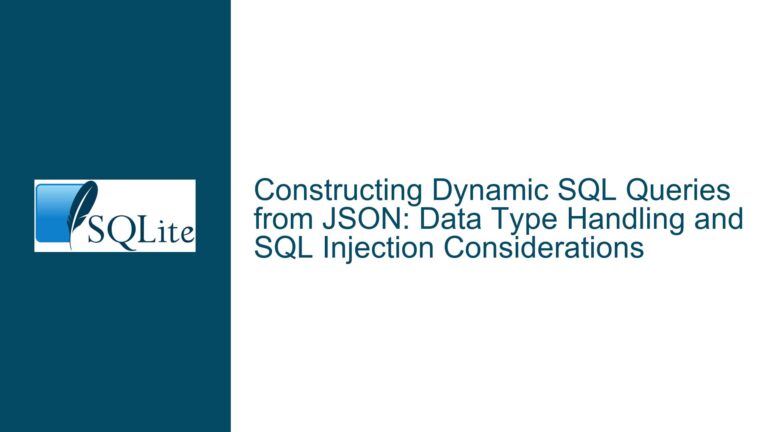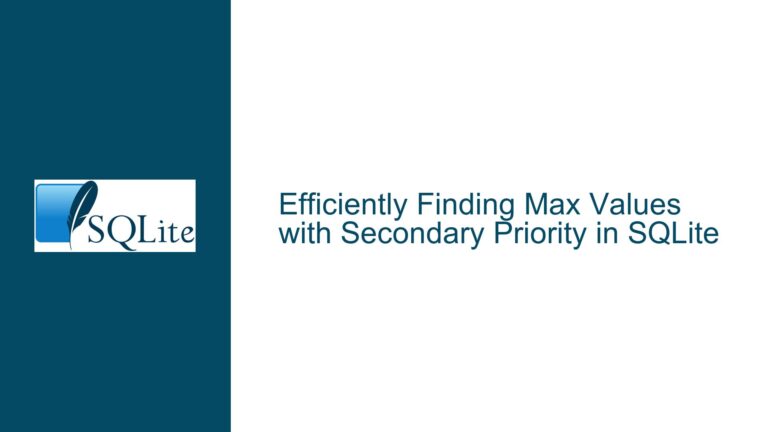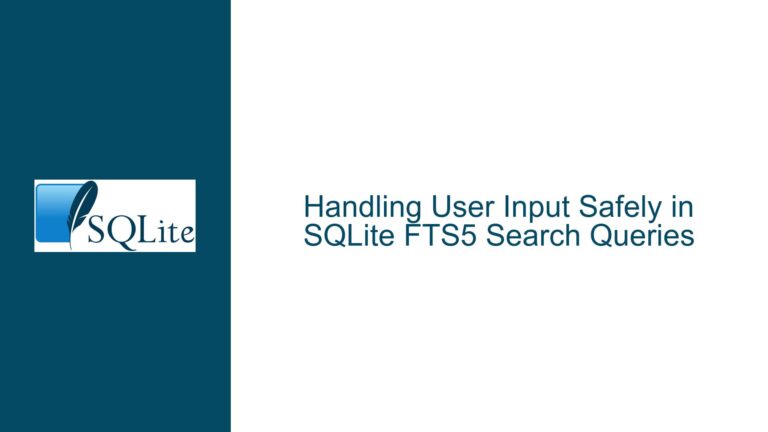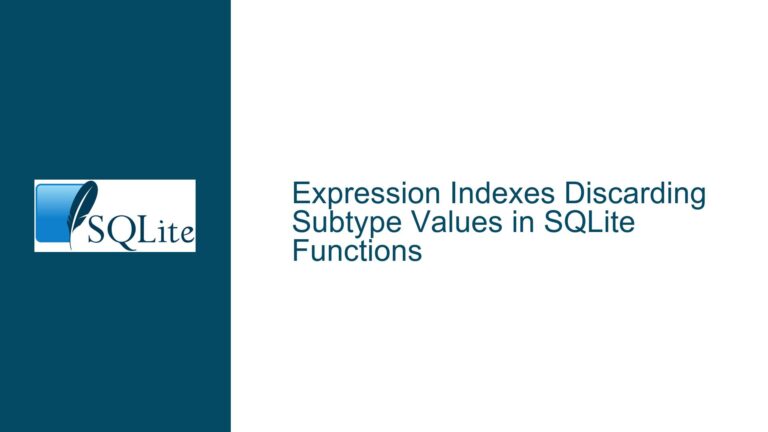Enabling Dynamic Column Schemas in SQLite Virtual Tables and Table-Valued Functions
Issue Overview: Static Column Definitions in Virtual Tables and Table-Valued Functions
SQLite’s virtual tables and table-valued functions (TVFs) are powerful tools for integrating external data sources into SQL queries. However, these mechanisms require predefined static column schemas at the time of table creation or function registration. This limitation becomes problematic when working with dynamic data sources such as CSV files, JSON APIs, or other formats where the column structure varies per input.
For example, a CSV file virtual table implementation typically requires defining columns upfront using CREATE VIRTUAL TABLE, which is impractical when the goal is to query arbitrary CSV files without prior knowledge of their schema. Similarly, a TVF designed to fetch data from a JSON API cannot dynamically expose columns like title or comments if those fields are not hardcoded in the function definition. This rigidity forces developers to choose between inefficient workarounds (e.g., loading entire datasets into temporary tables) or abandoning SQLite’s native extensibility features altogether.
The core challenge stems from SQLite’s query planner, which relies on static schema metadata to validate column references, optimize execution plans, and enforce type constraints. If a virtual table or TVF could return dynamic columns, the planner would lack the necessary information to resolve column names during parsing, leading to errors like no such column or ambiguous references. This creates a chicken-and-egg problem: the schema must be known before parsing the query, but the schema depends on runtime data.
Possible Causes: Architectural Constraints and Metadata Resolution
1. Query Planning Requires Predefined Schemas
SQLite’s query planner operates during the prepare phase of statement execution. At this stage, the planner resolves table and column names, validates syntax, and generates an execution plan. Virtual tables and TVFs must provide a fixed list of columns during this phase. For example, when a user writes SELECT * FROM csv('data.csv'), the csv TVF must declare its columns before the planner can proceed. If the columns vary per file, the planner cannot guarantee their existence, leading to unresolved symbols.
2. Virtual Table Module Limitations
The virtual table API in SQLite (sqlite3_module) mandates that modules implement the xCreate or xConnect methods, which define the table’s schema. This schema is cached in the sqlite_master table and reused for subsequent queries. While modules can theoretically alter their schema at runtime (e.g., by parsing a CSV header), SQLite does not provide a mechanism to refresh the cached schema without dropping and recreating the virtual table. This makes dynamic schemas impractical for ad-hoc queries.
3. Type Affinity and Storage Model
SQLite’s storage model associates type affinity with columns, influencing how values are stored and compared. Dynamic columns would complicate type handling, as affinity could not be predetermined. For instance, a CSV column containing integers in one file and strings in another would require runtime type detection, conflicting with SQLite’s static type system.
4. Table-Valued Function Registration
TVFs registered via the sqlite3_create_module or vtfunc extension must define their output columns during initialization. The vtfunc framework, for example, requires a columns array specifying column names and types. This registration occurs once, at function creation time, making it impossible to adjust columns based on runtime parameters like file paths or API URLs.
Troubleshooting Steps, Solutions & Fixes: Strategies for Dynamic Schema Support
1. Leverage JSON Extension for Schema-Agnostic Storage
SQLite’s JSON1 extension provides a workaround by storing entire rows as JSON objects in a single column. This avoids the need for predefined schemas:
SELECT json_extract(value, '$.name') AS name
FROM json_each(readfile('users.csv'));
Here, readfile could be a TVF that reads the CSV and returns rows as JSON. However, this approach shifts schema resolution to the query author, who must manually extract fields using json_extract. It also incurs overhead from JSON parsing and lacks the performance benefits of native column storage.
2. Preprocessing Data to Infer Schemas
For file-based data sources (CSV, Parquet), a preprocessing step can infer the schema by analyzing the first few rows. This metadata can then dynamically generate a virtual table definition:
-- Pseudocode for dynamic virtual table creation
DECLARE columns TEXT = (SELECT group_concat(header || ' TEXT', ', ') FROM csv_headers('data.csv'));
EXECUTE IMMEDIATE 'CREATE VIRTUAL TABLE temp.dynamic_csv USING csv_auto(''data.csv'', columns=' || columns || ')';
This requires extending the virtual table module to accept a list of columns as a parameter. The csv_auto module would parse the header row and map columns accordingly. While feasible, this method complicates query execution and requires temporary tables, which may not scale for concurrent operations.
3. Modifying the Virtual Table Module
Advanced users can modify the virtual table module to support dynamic schemas by overriding the xBestIndex and xFilter methods. In xBestIndex, the module could parse the CSV header to determine available columns and communicate this to the planner via sqlite3_declare_vtab. However, SQLite expects xBestIndex to be called before xFilter, creating a race condition: the header must be read before schema declaration, but the schema is needed during planning.
A potential solution involves lazy schema initialization:
- In
xConnect, create a placeholder schema with a single column (e.g.,_dynamic). - During
xBestIndex, check if the actual schema has been loaded. If not, read the data source (e.g., CSV header) and callsqlite3_declare_vtabwith the correct columns. - Handle schema mismatches by resetting the prepared statement.
This approach risks instability, as redefining a virtual table’s schema after preparation is unsupported and may lead to crashes or undefined behavior.
4. Custom SQLite Builds with Dynamic TVFs
Modifying SQLite’s source code to support dynamic TVFs involves extending the sqlite3_vtab structure to include a callback for column resolution. For example:
struct sqlite3_vtab {
const sqlite3_module *pModule;
int nRef;
char *zErrMsg;
// New field: function to resolve columns
int (*xResolveColumns)(sqlite3_vtab *pVTab, const char *zParam, char **pazCols, int *pnCols);
};
The TVF could then implement xResolveColumns to parse the data source (e.g., CSV file) and return the column list. The planner would invoke this callback during the prepare phase, allowing dynamic column resolution. This change would require significant modifications to SQLite’s internals, including updates to the parser, planner, and virtual table API.
5. Proxy Tables with Schema Discovery
A proxy table can act as an intermediary, deferring schema discovery to query execution. The proxy would:
- Intercept queries targeting dynamic sources (e.g.,
SELECT * FROM proxy_csv('data.csv')). - Invoke a helper function to extract the schema from
data.csv. - Rewrite the query to use a temporary virtual table with the inferred schema.
- Execute the rewritten query.
This method avoids SQLite modifications but introduces complexity in query rewriting and temporary table management. It also impacts performance due to the overhead of schema inference and DDL execution.
6. Hybrid Approach: Schema Caching
Combine schema inference with caching to minimize preprocessing. For example:
- Maintain a global cache mapping file paths to schemas.
- On first access, infer the schema and store it in the cache.
- For subsequent queries, reuse the cached schema unless the file’s modification time changes.
This optimizes repeated queries but still requires initial schema extraction and cache management.
7. Community Extensions and Forks
Explore community projects like sqlite-vtfunc or csv-virtual-table that attempt dynamic schemas. These may provide experimental APIs or workarounds. For instance, sqlite-vtfunc could be patched to accept a schema callback:
from vtfunc import TableFunction
class DynamicCSV(TableFunction):
params = ['filename']
columns = ['dynamic']
def initialize(self, filename):
headers = parse_csv_headers(filename)
self.columns = headers # Dynamically update columns
While such patches may not upstream into SQLite, they offer a stopgap solution for specific use cases.
8. Advocating for Core Feature Support
Engage with SQLite’s development team to advocate for native dynamic schema support. A formal proposal might include:
- A new virtual table flag (e.g.,
SQLITE_VTAB_DYNAMIC_SCHEMA) indicating that the module handles column resolution. - Extensions to
sqlite3_declare_vtabto allow late schema declaration. - Planner adjustments to handle schema changes during preparation.
This path is long-term and depends on the SQLite team’s priorities but aligns with the community’s growing need for flexible data integration.
Each strategy involves trade-offs between flexibility, performance, and complexity. Developers must weigh these factors based on their specific requirements, such as query latency, data volatility, and deployment constraints. Until SQLite natively supports dynamic schemas, hybrid approaches combining JSON, preprocessing, and cautious virtual table modifications offer the most pragmatic path forward.






